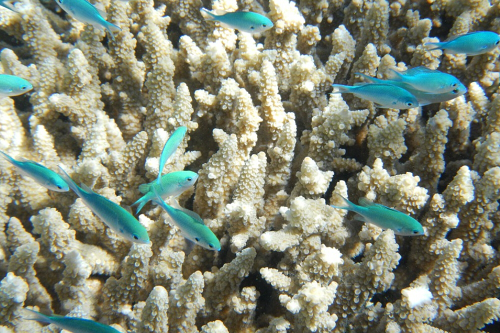Great Barrier Reef’s Third Mass Bleaching in Five Years the Most Widespread Yet
海水温度升高 大堡礁五年内出现第三次大规模珊瑚白化
The government’s top Great Barrier Reef scientist says a third mass bleaching event in five years is a clear signal the marine wonder is “calling for urgent help” on climate change.
澳大利亚政府大堡礁研究的权威科学家表示,五年内大堡礁发生第三次大规模白化现象,这是大堡礁这一海洋奇迹“呼吁紧急援助”应对气候变化的明确信号。
One quarter of the Great Barrier Reef suffered severe bleaching this summer in the most widespread outbreak ever witnessed, according to analysis of aerial surveys of more than 1,000 individual reefs released on Tuesday.
根据本周二(4月7日)发布的一项对1000多个独立珊瑚礁的航空调查分析,今年夏天,在有史以来暴发最广泛的白化现象中,大堡礁四分之一的区域出现了严重白化。
Dr David Wachenfeld, chief scientist at the Great Barrier Reef Marine Park Authority, told Guardian Australia: “My greatest fear is that people will lose hope for the reef. Without hope there’s no action.
大堡礁海洋公园管理局首席科学家大卫·瓦肯菲尔德博士告诉《卫报》澳大利亚版说:“我最担心的是人们会对大堡礁失去希望。没有希望就没有行动。”
“People need to see these [bleaching] events. They are clear signals the Great Barrier Reef is calling for urgent help and for us to do everything we can.”
“人们需要看到这些(白化)现象。这是大堡礁正在呼吁我们紧急帮助、竭尽所能的明确信号”。
Prof Terry Hughes, director of the Centre of Excellence for Coral Reef Studies at James Cook University, surveyed 1,036 reefs from a plane over nine days in late March. The marine park authority also had an observer on the flights.
3月下旬,詹姆斯库克大学卓越珊瑚礁研究中心主任特里·休斯教授在9天的时间里,从飞机上对1036个珊瑚礁进行了调查。海岸公园管理局也派出了一名观察员。
Hughes has released maps showing severe levels of bleaching occurred in 2020 in all three sections of the reef – northern, central and southern – the first time this has happened since mass bleaching was first seen in 1998.
休斯发布的地图显示,在2020年,大堡礁北部、中部和南部三个部分都出现了严重的白化现象,这是自1998年首次发现大规模白化现象以来首次出现这种情况。
Some 25% of the reefs were severely bleached – meaning that more than 60% of the corals on each reef had bleached.
大约25%的珊瑚礁严重白化,这意味着每个珊瑚礁上超过60%的珊瑚已经白化。
Hughes said previous observations had shown that bleaching at that extent leads to “high levels of mortality” of corals.
休斯说,先前的观察显示,这种程度的白化会导致珊瑚的“高死亡率”。

The Great Barrier Reef has experienced five mass bleaching events – 1998, 2002, 2016, 2017 and 2020 – all caused by rising ocean temperatures driven by global heating.
1998年、2002年、2016年、2017年和2020年,大堡礁共经历了五次大规模的白化,都是由全球变暖导致的海洋温度上升造成的。
Hughes said there probably would not be the same level of coral death in the north and central regions in 2020 as in previous years, but this was partly because previous bleaching outbreaks had killed off the less heat-tolerant species.
休斯说,今年,大堡礁北部和中部地区的珊瑚死亡水平可能达不到往年的水平,但部分原因是之前的白化暴发已经导致耐热性较差的珊瑚死亡。
The 2020 bleaching was second only to 2016 for severity, Hughes said.
休斯表示,2020年的白化严重程度仅次于2016年。
Corals can recover from mild bleaching, but scientists say those corals are more susceptible to disease. Severe bleaching can kill corals.
珊瑚可以从轻微的白化中恢复,但科学家表示,这些珊瑚更容易生病。严重的白化甚至会杀死珊瑚。
“It’s not too late to turn this around with rapid action on emissions,” he said.
休斯说:“现在快速采取行动来扭转这种局面还为时不晚”。
In February the reef was subjected to its hottest sea surface temperatures since records began in 1900.
今年2月,大堡礁遭遇了自1900年有记录以来最高的海平面温度。
Some scientists fear that rising levels of heat being taken up by the ocean have pushed tropical reefs to a tipping point at which many locations bleach almost annually.
一些科学家担心,海洋吸收的热量不断上升,将热带珊瑚礁推向了一个临界点,许多地方几乎每年都在白化。
Wachenfeld said the reef’s sheer size – it comprises about 3,000 individual reefs – made it resilient, “but climate change brings a new scale of impact unlike anything we have seen before”.
瓦肯菲尔德说,大堡礁庞大的体积使其复原能力很强,“但气候变化带来的影响是前所未有的”。大堡礁由大约3000个独立的珊瑚礁组成。
“No one climate event will kill the Great Barrier Reef, but each successive event creates more damage. Its resilience is not limitless and we need the strongest possible action on climate change.”
“单一的气候事件不会‘杀死’大堡礁,但持续的气候变化会对其造成更多的破坏。大堡礁的恢复能力不是无限的,我们需要对气候变化采取最强有力的行动。”
The globe has already warmed by about 1C above pre-industrial levels, caused primarily by rising levels of greenhouse gases in the atmosphere from burning fossil fuels.
全球气温已经比工业化前升高了约1摄氏度,这主要是由于燃烧化石燃料导致大气中温室气体含量上升所致。
Measures to improve the resilience of the reef include improving water quality, controlling outbreaks of coral-eating starfish, and research and development to improve the heat tolerance of corals.
改善珊瑚礁复原力的措施包括改善水质、控制食珊瑚海星的爆发,以及研究如何改善珊瑚的耐热性。
“None of that is a substitute for strong action on emissions,” Wachenfeld said. “Dealing with the climate problem is the underpinning for everything else to work.”
瓦肯菲尔德说:“所有这些都不能替代对排放采取强有力的行动。解决气候问题是其他一切措施有效的基础”。
Queensland’s minister for environment and the Great Barrier Reef, Leeanne Enoch, said climate change, pollution from run-off and other threats “are testing the reef’s ability to recover from major disturbances like mass bleaching events, severe tropical cyclones and crown-of-thorns starfish.”
昆士兰州环境与大堡礁部长莉安·伊诺克表示,气候变化、径流污染和其他威胁“正在考验大堡礁从大规模白化、严重的热带气旋和棘冠海星等重大干扰中恢复的能力”。
“The missing piece continues to be leadership and action from the federal government on climate change,” she said.
她说:“澳大利亚联邦政府在气候变化问题上的领导和行动仍然不足。”
英文、中文版本下载:http://www.yingyushijie.com/shop/source/detail/id/2131.html








